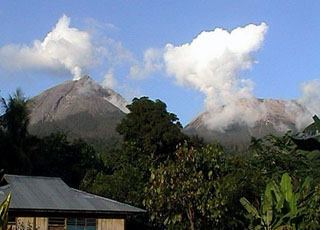Report on Lewotobi (Indonesia) — 18 June-24 June 2025
Smithsonian Institution / US Geological Survey
Weekly Volcanic Activity Report, 18 June-24 June 2025
Managing Editor: Sally Sennert.
Please cite this report as:
Global Volcanism Program, 2025. Report on Lewotobi (Indonesia) (Sennert, S, ed.). Weekly Volcanic Activity Report, 18 June-24 June 2025. Smithsonian Institution and US Geological Survey.
Lewotobi
Indonesia
8.542°S, 122.775°E; summit elev. 1703 m
All times are local (unless otherwise noted)
The Pusat Vulkanologi dan Mitigasi Bencana Geologi (PVMBG) reported that eruptive activity continued at Lewotobi Laki-laki during 18-25 June, after the explosive eruption on 17 June. At 0318 and 0641 on 18 June ash plumes rose 1 km above the summit and drifted N and NE. Visual observations of eruptive events recorded at 1229 and 2212 later that day, and at 0922 and 1008 on 19 June, were obscured by weather conditions; incandescence at the summit was visible in a webcam image at 2223 on 18 June. Dense gray ash plumes rose as high as 2 km above the summit and drifted S and SW at 2213 and 2231 on 20 June and at 0014 and 0024 on 21 June. Webcam images taken near midnight showed incandescent material being ejected above the summit and onto the upper flanks. An eruptive event was recorded at 1440 on 23 June but weather conditions again obscured views. According to news reports the number of evacuees totaled 4,954 on 19 June and 4,007 as of 21 June. The Alert Level remained at 4 (on a scale of 1-4) and the public was warned to stay 7 km away from the center of Laki-laki and 8 km in a semicircle clockwise from the SW to the NE.
Geological Summary. The Lewotobi edifice in eastern Flores Island is composed of the two adjacent Lewotobi Laki-laki and Lewotobi Perempuan stratovolcanoes (the "husband and wife"). Their summits are less than 2 km apart along a NW-SE line. The conical Laki-laki to the NW has been frequently active during the 19th and 20th centuries, while the taller and broader Perempuan has had observed eruptions in 1921 and 1935. Small lava domes have grown during the 20th century in both of the summit craters, which are open to the north. A prominent cone, Iliwokar, occurs on the E flank of Perampuan.
Sources: Pusat Vulkanologi dan Mitigasi Bencana Geologi (PVMBG, also known as CVGHM), Antara News, Antara News

